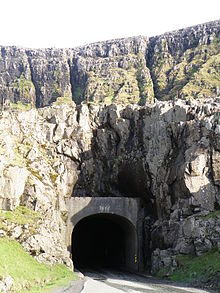This is an old revision of this page, as edited by Atlantic306 (talk | contribs) at 22:30, 29 July 2020 (Filled in 5 bare reference(s) with reFill 2). The present address (URL) is a permanent link to this revision, which may differ significantly from the current revision.
Revision as of 22:30, 29 July 2020 by Atlantic306 (talk | contribs) (Filled in 5 bare reference(s) with reFill 2)(diff) ← Previous revision | Latest revision (diff) | Newer revision → (diff) Entrance near Hvalba Entrance near Hvalba | |
| Overview | |
|---|---|
| Location | Hvalba and Trongisvágur, Faroe Islands |
| Status | In operation |
| Operation | |
| Work begun | 1961 |
| Opened | 1963 |
| Owner | Landsverk |
| Operator | Landsverk |
| Traffic | Automotive |
| Vehicles per day | 900 (2017) |
| Technical | |
| Length | 1,450 m (4,760 ft) |
| No. of lanes | 1 |
| Operating speed | 80 km/h (50 mph) |
| Highest elevation | 227 m (745 ft) |
| Lowest elevation | 150 m (490 ft) |
| Tunnel clearance | 3.2 m (10 ft) |
| Width | 3.3 m (11 ft) |
| Grade | 5.61% |
| Overview | |
|---|---|
| Location | Hvalba and Trongisvágur, Faroe Islands |
| Status | Under construction |
| Operation | |
| Work begun | 2019 |
| Opened | 2021 |
| Owner | Landsverk |
| Operator | Landsverk |
| Traffic | Automotive |
| Vehicles per day | 2,000 (2030) |
| Technical | |
| Length | 2,050 m (6,730 ft) |
| No. of lanes | 2 |
| Operating speed | 80 km/h (50 mph) |
| Highest elevation | 101 m (331 ft) |
| Lowest elevation | 81 m (266 ft) |
| Tunnel clearance | 4.6 m (15 ft) |
| Width | 7.0 m (23.0 ft) |
| Grade | 6.00 % |
The Hvalbiartunnilin (Hvalba Tunnel) is the name applied to two tunnels on the island of Suðuroy in the Faroe Islands. The first Hvalbiartunnilin is the oldest tunnel in the country, and is currently being replaced by a modern one. Both tunnels connect the villages Hvalba and Trongisvágur. The tunnels are owned and maintained by public works authority Landsverk.
History
The centuries before the tunnel arrived, Hvalba and Trongisvágur were connected by a footpath via the Krákugjógv. Construction of the Hvalbiartunnilin started in 1961 and it opened in 1963, as the first tunnel in the country. It has always remained an unlit, one-lane tunnel, measuring 1.450 metres in length. Because of its limited clearance of 3.2 metres, it cannot handle modern-sized large vehicles, such as lorries, trailers and touringcars, which impedes transport to the rest of the island and onwards to Tórshavn. Although the tunnel has passing places at regular intervals, this hinders quick passage of the tunnel in especially the northbound direction, as these vehicles need to yield to oncoming southbound cars. The footpath is still a popular hiking route.
In 2017 it was decided to replace the old tunnel with a new tunnel. This tunnel, with two lanes and a clearence of 4.5 meters, measures 2.500 metres in length. Drilling started on 27 June 2019 and finished on 7 July 2020. A new access road of 2.4 kilometres is constructed on the Hvalba side and 1.4 km on the Trongisvágur side. The tunnel is built by ArtiCon and LNS. Planned to open in 2021, the tunnel cost 272 million DKK. What will remain of the old tunnel is unknown.
The new Hvalbiartunnilin will gain extra importance if the subsea Suðuroyartunnilin is constructed between Hvalba or Sandvík on Suðuroy and the isle of Sandoy. This tunnel is yet to be decided upon, but should according to plans open around 2030. Sandoy is connected to capital Tórshavn and the rest of the country via the Sandoyartunnilin.
See also
References
- ^ "Hvalbiartunnilin". http.
- "Tunlar". http.
- "Nýggi Hvalbiartunnilin verður skotin ígjøgnum týsdagin". dagur.fo.
- ^ "Útbjóðing av Hvalbiartunlinum". http.
- "Suðuroyartunnilin". http.